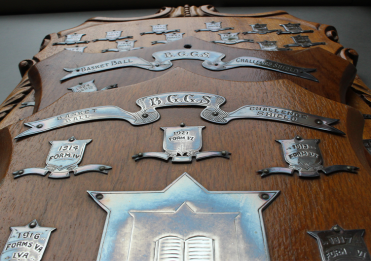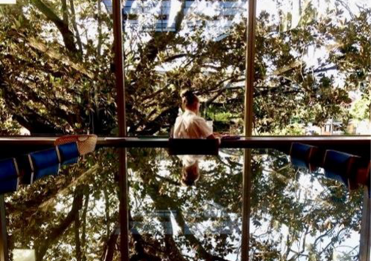The designated Girls Grammar uniform has always included a white blouse, royal blue tie with a navy skirt for all events—right? Wrong! There have also been three all-white dresses in our history: the boarders’ church frocks; the QGSSSA tunics for Athletics and Ballgames; and Speech Day attire.
In particular, BGGS boarding students had a range of uniforms, and one of these was the church frock. Caroline Mercer (Cavaye, 1971) reminisces that they:
‘… had so many uniforms in the late 60s (especially) that white church dress—short sleeves, button front, pleated skirt, slim belt, touching the floor when kneeling, ‘natural’ stockings with suspenders, black lace-ups, the old school hat. We walked down to St John’s Cathedral on Sunday morning, crossing the road in a column to avoid sharing the footpath with Grammar boys. Supervised all the way of course.’

1945: Beth Evans, ‘ready for church Sunday uniform’
Part of this outfit was a pair of wrist-length white gloves. Past boarders also remember that they also wore their church dress to Speech Night. While white for these occasions might have been traditional, it must have been a nightmare for the School laundry to keep all these white dresses cleaned and pressed.

1966: Boarders in white church frocks waiting to greet the American President, Lyndon Baines Johnson
Jenny Underwood (Oswin, 1976) well remembers the white church frocks and their phasing out. ‘I have a feeling when a new Head Boarding Mistress was appointed, the church frock may have been retired.’ Jenny’s sister, Julie, remembers not wearing the church frock when Mrs Judith Hancock commenced as Principal in 1977. I am sure the laundry staff would have been grateful for the demise of these white frocks.

(Left) 1956: Helen Stanley and Val Wood in their church frocks (Right) 1956: Rayna Scott and Val Wood
The formality and visibility of the white dress carried over to other activities. The archive has a diverse range of photographs of Athletics and sporting teams proudly wearing white tunics to represent their School at QGSSSA competitions.

1938: White box pleated tunic
In 1944, Meg Rorke, one of the first Physical Education graduates from The University of Queensland, was appointed as Visiting Mistress, Gymnastics and then, in 1945, as an Assistant Mistress. She was the first of the ‘modern’ Physical Education teachers with up-to-date views on sports psychology, sports science, coaching, and mentoring. Meg Rorke, who looked for an edge in all her coaching, reintroduced in 1949 the white athletics tunic, forgoing the three-box-pleated version for a more tailored look. She stated that the girls would look ‘smart and professional’ in their new, white uniforms. No doubt, this strategic decision made Grammar girls stand out from all the other schools who were predominantly attired in navy blue.

1953 Senior Relay: Nola Welch receiving the baton and Lois Murphy acting as starting blocks
The white Athletics and Ballgames tunics reflected the physical education clothing of each era. The School archive has photographs of girls in the three box-pleated tunics and white babushkas, the waisted 1950s gym tunic versions, and the A-line 1960s and 70s models. The use of this white dress lasted until 1967. I wonder at the logic of having athletes wearing something that would show dirt and grass stains so easily and I wonder what the athletes’ mothers thought of the washing it entailed. Irrespective of that idea, I know the Grammar girls who donned that ‘white dress’ did so with immense pride. Pauline Harvey-Short (1971) remembers: ‘I wore the white A-line tunic for my first year in 1967 with a matching babushka. It felt very special as our daily gym tunics of the same design were royal blue and the white really “popped” at the QGSSSA Athletics’.

1967 Athletics and Ballgames Team showing both the old waisted tunic and the new A Line tunic design
The idea that schoolgirls should be attired in white was not an idea exclusive to Grammar. There are still some Brisbane girls’ schools that wear white Speech Night dresses. My own first Speech Day required me to wear a white dress, along with the rest of the student body. My only, rather old, white dress was deemed appropriate by my mother because I would get lost ‘in all the other white dresses’. This approach was somewhat compromised by the fact that I discovered I had to walk across the stage in front of everybody. Cue new dress and wrist-length white gloves. The occasion also required curtsey practice as I had to receive a prize from Lady May Abel-Smith, the wife of the then Governor of Queensland. I remember that the new dress and the gloves impressed upon me that this was a special and important occasion. I wore that same dress to each Speech Day until Year 12. It no longer exists, nor can I find a photograph of me at any of these events. However, the School archive has an elegant photograph of Ceri Davies at her 1961 Speech Night, as well as Kay Barlow’s (1963-66) lovely voile dress, made by her mother with a broderie Anglaise lace-trimmed petticoat. It enriches the understanding of our history that past students have preserved these wonderful artefacts and generously gifted them back to us.

1961: Ceri Davies at Speech Night, City Hall in her white dress and gloves

1966 The voile Speech Day dress belonging to Kay Barlow
These three white dresses reveal, in varying degrees, so many facets of the Grammar girl: demure; formal; jubilant; proud; athletic; and academic. Sometimes what you wear contributes to how you feel or the image you project and the choice of white may be explained by the formality and traditions of ceremonial occasions—Speech Day and attendance at church, and the statement of pride in representing your School when athletes strove to perform at their absolute best: the Athletics uniform.
One of the most significant aspects of the Girls Grammar uniform is its continuity. The 1922 student would not find the 2022 uniform unrecognisable. There have been various attempts to change its components but, in each case, it has been the students who reject the idea. There have been minor adjustments to what the Grammar girl wore; however, there are ‘dresses’ that have been lost in time. I think back with some nostalgia for that white dress I wore to every one of my Speech Nights. When talking to past Grammar girls, be they day students, or boarders, or athletes, many have their own clear memories of wearing one or more of those three white dresses.
Mrs Kristine Cooke (Harvey, 1967)
English Teacher

1950 Sunday Mail p19




